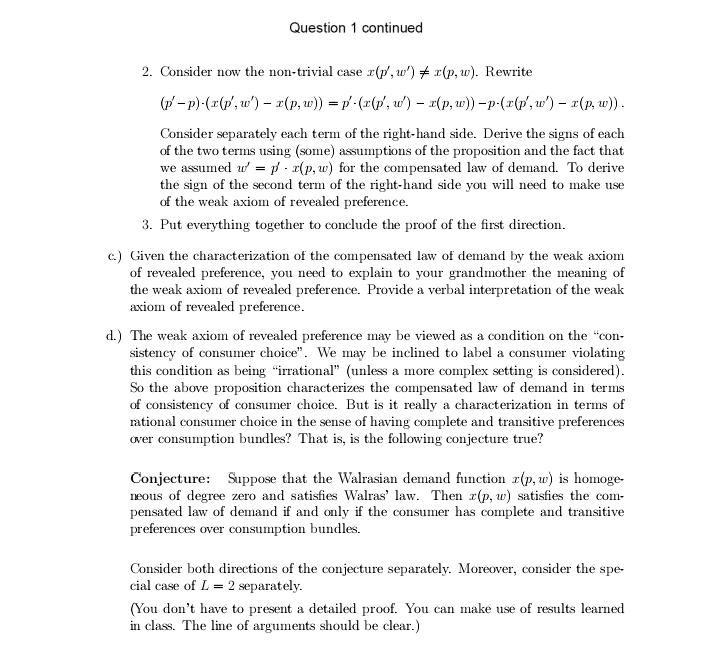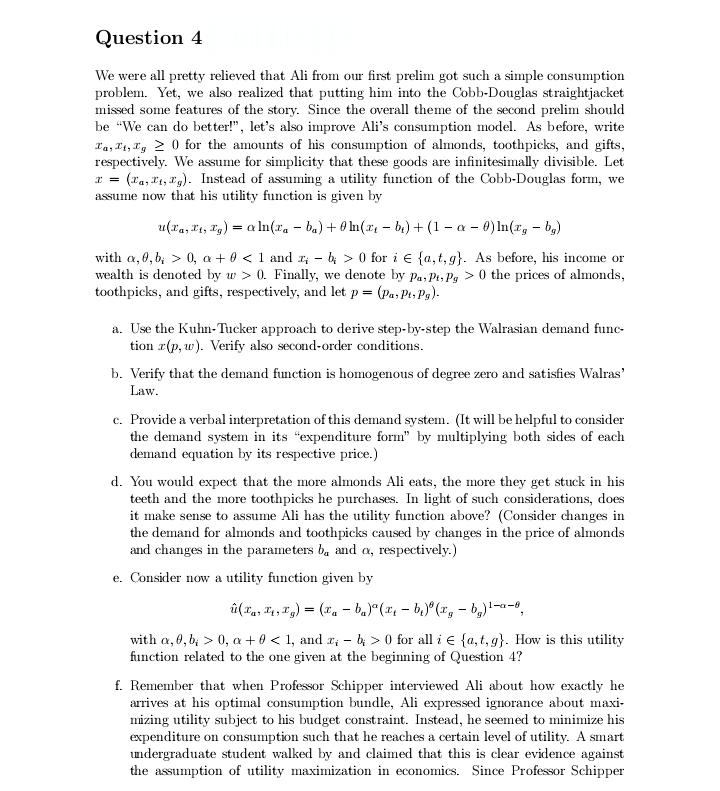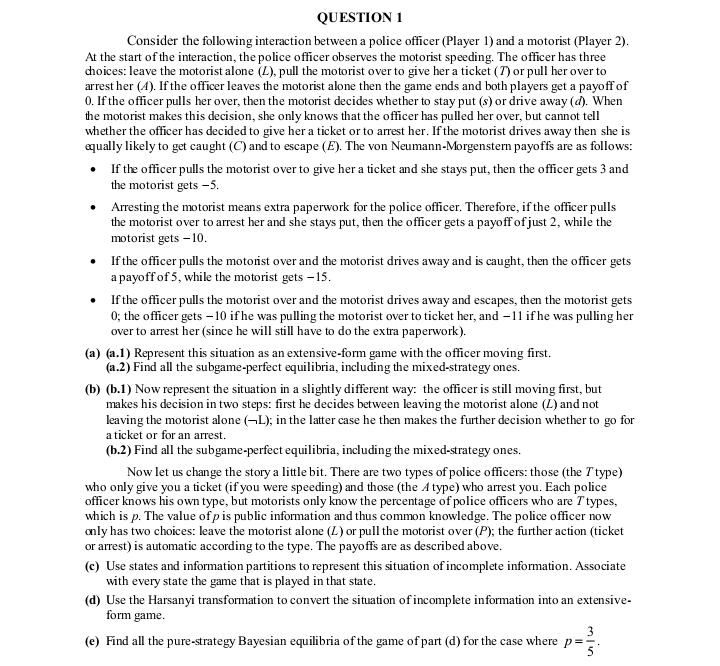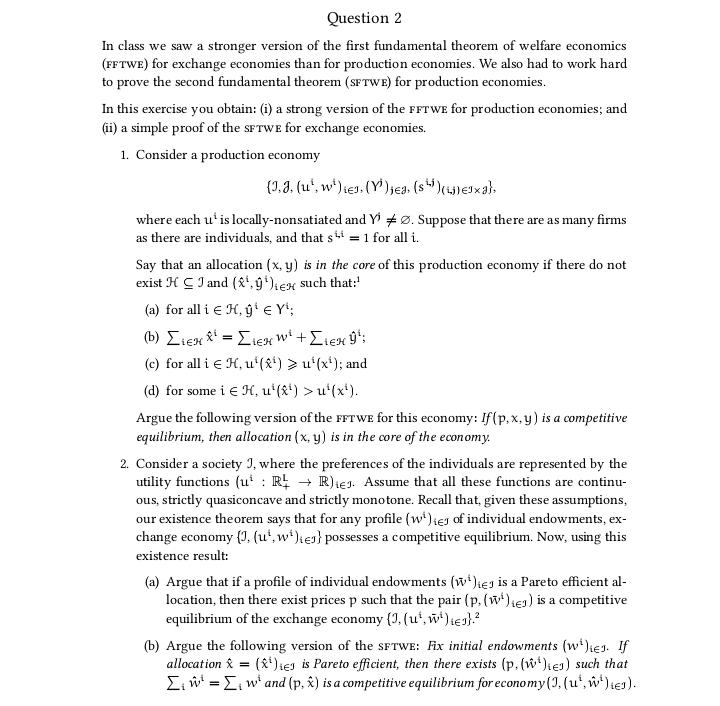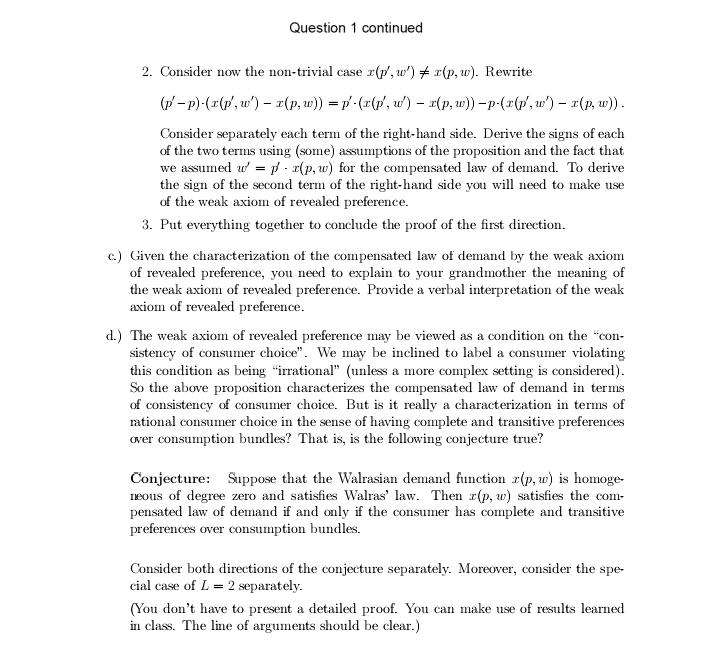
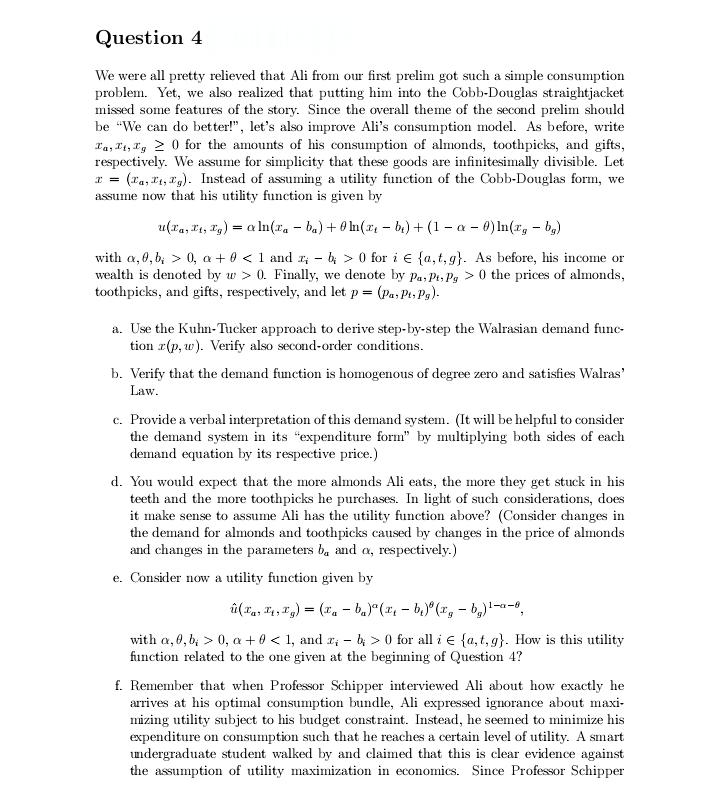
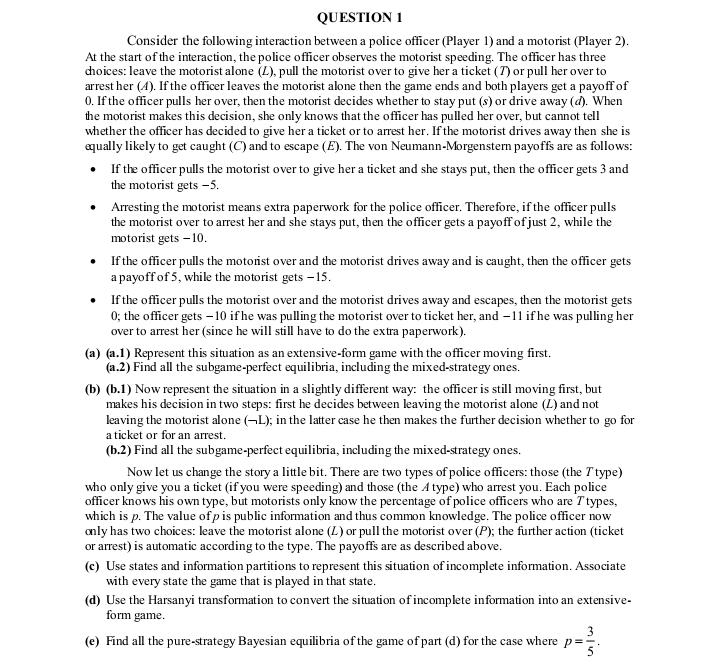
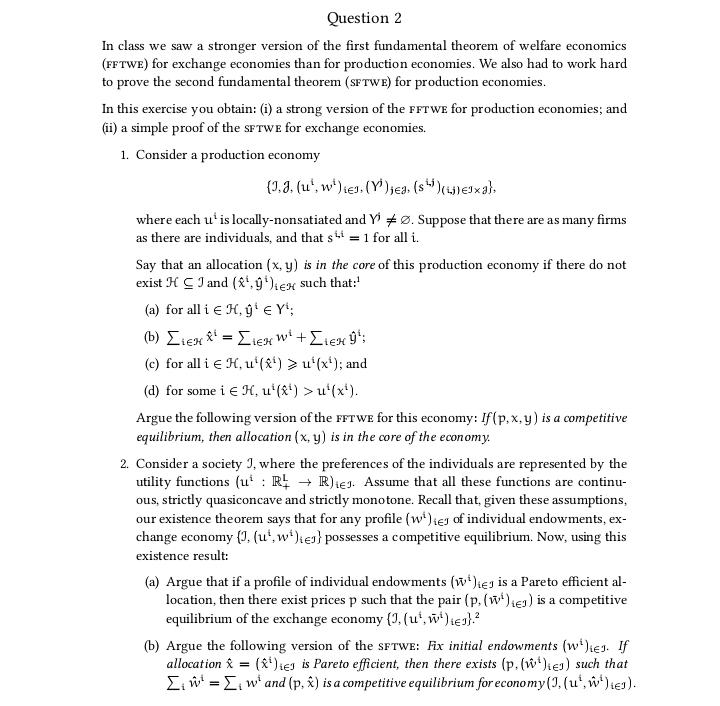
Solve them clearly..r
Question 1 continued 2. Consider now the non-trivial case r(p', w') # x(p, w). Rewrite ('-p)(up,w')- r(p, w)) = p.(x(p, w) - r(p,w))-p-(r(p,w') - r(p, w)) . Consider separately each term of the right-hand side. Derive the signs of each of the two terms using (some) assumptions of the proposition and the fact that we assumed w = p - r(p,w) for the compensated law of demand. To derive the sign of the second term of the right-hand side you will need to make use of the weak axiom of revealed preference. 3. Put everything together to conclude the proof of the first direction. ") Given the characterization of the compensated law of demand by the weak axiom of revealed preference, you need to explain to your grandmother the meaning of the weak axiom of revealed preference. Provide a verbal interpretation of the weak axiom of revealed preference. d.) The weak axiom of revealed preference may be viewed as a condition on the "con- sistency of consumer choice". We may be inclined to label a consumer violating this condition as being "irrational" (unless a more complex setting is considered). So the above proposition characterizes the compensated law of demand in terms of consistency of consumer choice. But is it really a characterization in terms of rational consumer choice in the sense of having complete and transitive preferences over consumption bundles? That is, is the following conjecture true? Conjecture: Suppose that the Walrasian demand function r(p, w) is homoge- neous of degree zero and satisfies Walras' law. Then r(p, w) satisfies the com- pensated law of demand if and only if the consumer has complete and transitive preferences over consumption bundles. Consider both directions of the conjecture separately. Moreover, consider the spe- cial case of L = 2 separately. (You don't have to present a detailed proof. You can make use of results learned in class. The line of arguments should be clear.)Question 4 We were all pretty relieved that Ali from our first prelim got such a simple consumption problem. Yet, we also realized that putting him into the Cobb-Douglas straightjacket missed some features of the story. Since the overall theme of the second prelim should be "We can do better!", let's also improve Ali's consumption model. As before, write Ta, It, Is 2 0 for the amounts of his consumption of almonds, toothpicks, and gifts, respectively. We assume for simplicity that these goods are infinitesimally divisible. Let I = (Ta, 14, By). Instead of assuming a utility function of the Cobb-Douglas form, we assume now that his utility function is given by u(Ta, It, 19) = aln(Ta - ba) +Ol(1, - b,) + (1 - 0 - 0) In(1, - by) with a, 0, b; > 0, a + 0 0 for ie {a, t, g}. As before, his income or wealth is denoted by w > 0. Finally, we denote by P., p., P, > 0 the prices of almonds, toothpicks, and gifts, respectively, and let p = (Pa, Pt, P,)- a. Use the Kuhn-Tucker approach to derive step-by-step the Walrasian demand func- tion r(p, w). Verify also second-order conditions. b. Verify that the demand function is homogenous of degree zero and satisfies Walras' Law. c. Provide a verbal interpretation of this demand system. (It will be helpful to consider the demand system in its "expenditure form" by multiplying both sides of each demand equation by its respective price.) d. You would expect that the more almonds Ali eats, the more they get stuck in his teeth and the more toothpicks he purchases. In light of such considerations, does it make sense to assume Ali has the utility function above? (Consider changes in the demand for almonds and toothpicks caused by changes in the price of almonds and changes in the parameters b, and a, respectively.) e. Consider now a utility function given by with a, 0, b > 0, a + 0 0 for all i e {o, t, g}. How is this utility function related to the one given at the beginning of Question 4? f. Remember that when Professor Schipper interviewed Ali about how exactly he arrives at his optimal consumption bundle, Ali expressed ignorance about maxi- mizing utility subject to his budget constraint. Instead, he seemed to minimize his expenditure on consumption such that he reaches a certain level of utility. A smart undergraduate student walked by and claimed that this is clear evidence against the assumption of utility maximization in economics. Since Professor SchipperQUESTION 1 Consider the following interaction between a police officer (Player 1) and a motorist (Player 2). At the start of the interaction, the police officer observes the motorist speeding. The officer has three choices: leave the motorist alone (2), pull the motorist over to give her a ticket (7) or pull her over to arrest her (A). If the officer leaves the motorist alone then the game ends and both players get a payoff of 0. If the officer pulls her over, then the motorist decides whether to stay put (s) or drive away (d). When the motorist makes this decision, she only knows that the officer has pulled her over, but cannot tell whether the officer has decided to give her a ticket or to arrest her. If the motorist drives away then she is equally likely to get caught (C) and to escape (E). The von Neumann-Morgenstern payoffs are as follows: . If the officer pulls the motorist over to give her a ticket and she stays put, then the officer gets 3 and the motorist gets -3. Arresting the motorist means extra paperwork for the police officer. Therefore, if the officer pulls the motorist over to arrest her and she stays put, then the officer gets a payoff of just 2, while the motorist gets -10. . If the officer pulls the motorist over and the motorist drives away and is caught, then the officer gets a payoff of 5, while the motorist gets -15. If the officer pulls the motorist over and the motorist drives away and escapes, then the motorist gets 0: the officer gets -10 if he was pulling the motorist over to ticket her, and -11 if he was pulling her over to arrest her (since he will still have to do the extra paperwork). (a) (a.1) Represent this situation as an extensive-form game with the officer moving first. (a.2) Find all the subgame-perfect equilibria, including the mixed-strategy ones. (b) (b.1) Now represent the situation in a slightly different way: the officer is still moving first, but makes his decision in two steps: first he decides between leaving the motorist alone (2) and not leaving the motorist alone (-L); in the latter case he then makes the further decision whether to go for a ticket or for an arrest. (b.2) Find all the subgame-perfect equilibria, including the mixed-strategy ones. Now let us change the story a little bit. There are two types of police officers: those (the Ttype) who only give you a ticket (if you were speeding) and those (the A type) who arrest you. Each police officer knows his own type, but motorists only know the percentage of police officers who are I types, which is p. The value of p is public information and thus common knowledge. The police officer now only has two choices: leave the motorist alone (Z) or pull the motorist over (P); the further action (ticket or arrest) is automatic according to the type. The payoffs are as described above. (c) Use states and information partitions to represent this situation of incomplete information. Associate with every state the game that is played in that state. (d) Use the Harsanyi transformation to convert the situation of incomplete information into an extensive- form game. (e) Find all the pure-strategy Bayesian equilibria of the game of part (d) for the case where p=;Question 2 In class we saw a stronger version of the first fundamental theorem of welfare economics (FFTWE) for exchange economies than for production economies. We also had to work hard to prove the second fundamental theorem (SETWE) for production economies. In this exercise you obtain: (i) a strong version of the FFTWE for production economies; and ii) a simple proof of the SFTWE for exchange economies. 1. Consider a production economy (J.J. (u', when. (Yea. (s " Juneaxal. where each u' is locally-nonsatiated and Y # 3. Suppose that there are as many firms as there are individuals, and that shi = 1 for all i. Say that an allocation (x, y) is in the core of this production economy if there do not exist H C J and (X',9' )exr such that:' (a) for all i c H, g' EY; (c) for all i e H, u'(&' ) > u'(x' ); and (d) for some i e H, u' (x ) > u'(x' ). Argue the following version of the FFTWE for this economy: If (p, x, y ) is a competitive equilibrium, then allocation (x, y) is in the core of the economy. 2. Consider a society ], where the preferences of the individuals are represented by the utility functions (u' : R4 - Rhiey. Assume that all these functions are continu- ous, strictly quasiconcave and strictly monotone. Recall that, given these assumptions, our existence theorem says that for any profile ( w )ies of individual endowments, ex- change economy {], (u', w'jes) possesses a competitive equilibrium. Now, using this existence result: (a) Argue that if a profile of individual endowments (Whigs is a Pareto efficient al- location, then there exist prices p such that the pair (p, (W' )igg) is a competitive equilibrium of the exchange economy (J. (u', when (b) Argue the following version of the SFTWE: Fix initial endowments (w hey. If allocation & = (X' )ies is Pareto efficient, then there exists (p, (w' )es) such that Low =[. w' and (p, * ) is a competitive equilibrium for economy (], (u', When)




